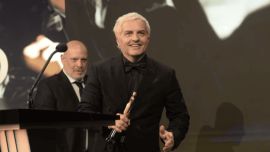Buildings give places dates, an age, a special identity.
The pyramids did that. Closer to our own short lives, newer buildings stand for a period. It happened with the Colón opera house which, in spite of not having a special profile, is still a symbol of high-grade fashionable Buenos Aires, for some of the world’s great performers as much as for the tourists. That was the reasoning, the logic for spending a week in Manaus, walking in and out of the Amazonas opera, once the Amazon Theatre, which has a special curriculum.
The theatre was the showpiece of the wealthy rubber millionaires of Manaus. The city’s jewel was approved in 1882 by the city’s Legislature and they decided that only the best materials should be used: iron from England, Italian marble, French crystal, and porcelain from Austria and Germany. After many delays in the search for first class craftsmen and master builders, the opera house opened on January 7, 1897. That was just a week after the then-(and notably first AfroBrazilian) governor of the Amazon, Eduardo Ribeiro, left office.
Riberiro was an engineer and he had been the prime mover of the theatre project and designer of the building’s dome, which has a surface made of 36,000 tiles in the colours of the Brazilian flag. He was eventually murdered in his 30s by a rival family to prevent him seeking another term in office. One of Brazil’s most brilliant authors, Euclides da Cunha, born in Rio de Janeiro, has written abundantly about the slain former governor, praising him.
The opera La Gioconda, by the Italian composer Amilcare Ponchielli, opened the theatre. It was an event that was celebrated for weeks. A popular rumour says that Italian opera tenor Enrico Caruso (1873-1921) sang there but no record can be found of this. At the time, he was just 21 and was not in Manaus when the theatre opened. And the rumoured presence of Russian prima ballerina Anna Pavlova (1881- 1931) and French actress Sarah Bernhardt (1844-1923) – originally Henriette-Rosine Bernard – also seems untrue.
However, the subject of the great temples of culture and politics in Latin America have a habit of coming back into circulation mixed with some contemporary topic.
In this case, the Manaus opera house came back tangentially with the film Fitzcarraldo, a 1982 West German production written and directed by Werner Herzog and starring Klaus Kinski, both of whom convey the impression of characters out of some amazing Amazon fiction. Beyond the film is the idea or model of the Manaus theatre.
Kinski acts as the title character and the story portrays an Irishman in love with the voice of Caruso, who is an aspiring millionaire in Peruvian rubber territory, Brian Sweeney Fitzgerald. He is known in Peru as ‘Fitzcarraldo,’ and his life project is to take a steamship over a hill to sail in rivers in Peru, which will eventually be made part of an opera house in Iquitos. Fitzcarraldo wants Enrico Caruso to open the theatre. The film’s character and his project are funded by the Irishman’s lover, Molly, played by Claudia Cardinale, a woman who owns a brothel. The tremendous labours to drag the steamship over a mountain to another river is carried out by Amazonian tribesmen who think the Irishman is mad, but they are accustomed to anything after centuries of slavery, it seems. The aim is to reach rubber territory in the Amazon basin.
However, like the tales of Caruso singing in Manaus, the real-life existence of Sweeney Fitzgerald is in doubt. Records of his life and work are impossible to find – even the entries on Wikipedia all refer to Herzog’s film.
The film is in part inspired by one Peruvian rubber baron though, a man called Carlos Fermín Fitzcarrald López (1862-1897), who definitely did exist and whose name was given to a river island in the forest waters. Fitzarrald was the eldest of five children of a US merchant seaman, William Fitzgerald, who married a Peruvian woman and changed his name to Guillermo Fitzcarrald. The young Fitzcarrald joined the Army aged 17 during Peru’s war with Chile (1879-1883), after which Bolivia became land-locked). The boy was suspected of spying for some foreign power and after a brief imprisonment and near execution he vanished for 10 years in the Amazon forest. Incredibly, he came out adding a full knowledge of the Quecha language to his fluent English. He became a “baron” in his own right, but is best remembered as a wealthy explorer adventurer in the Amazon region. He died by drowning at the age of 35 trying to save a crew member in river rapids.
That was the theatre that is Manaus and Manaus is the opera house.
A JOY
The Manaus opera was a joy up to 1910, when rubber exports dropped by 50 per cent. That signalled the end to nearly half a century of unlimited wealth, for some. The luxury palace that was the opera house and some of the palatial homes of the very rich and powerful began to decay. In the course of just a few years Manaus had become, along with Rio de Janeiro and São Paulo, one of the few cities in Brazil to have electric lighting, paved streets and big ports. Manaus was special, but the special began to fade.
Touches though remain today. Such as a street paved with rubber and sand bricks. It which surrounded the theatre so that the sound of horses and cart wheels should not hamper the sound of music as it was played. That rubber brick surface has been preserved today as part of the surrounding parking space.
It seems surprising today that the inside of the theatre should have survived so well. The ornamental shelves in black Carrara marble are there, so are the wall coverings of Portuguese red marble and the Murano crystal chandeliers that swing gently in the breeze in the main first-floor foyer once reserved for the upper classes gathering there – not even the actors and singers were allowed during the intervals in a performance.
The floors of different hard woods, such as the pale Palo Amarillo and the black Acapu from the forest have been polished to fresh standards. The dome inside over the audience, painted by Domenico de Angelis, has four corner perspectives so that people looking up feel they stand under the Eiffel Tower.
All this resisted the decadence. The audience and boxes that sit just over 1,000 people, became an indoor sports and fashion venue and a fuel depot during World War II.
A recovery mood set in during 1962. Restoration was attempted as from 1974 and completed by 1990. The final details took longer. But in 1997, to mark the centenary, the Theatre staged its first international music festival. Buenos Aires sent a strong contingent including the Colón’s music agent Miguel Lewi, orchestra directors Gustavo Plis and Esteban Gantzer, and Argentine singers Cecilia Diaz, Mónica Capra, Oscar Grassi and Rubén Martínez.
The opera had come to life again and Manaus celebrated the theatre. Next year the city prepares for its feast of 350 years since its beginnings, as a riverside fortress (San José de la Barra del Rio Negro) founded on October 24, 1669.


























Comments